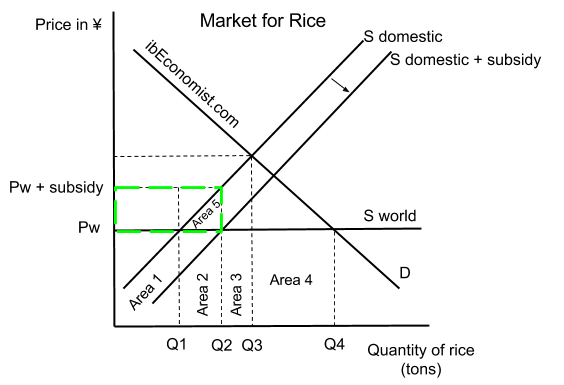Definition:
- Subsidy – government payment to producers attempting to lower the price of produce and increase quantity produced (encourage production). In the international trade context, the subsidy is given to domestic producers to increase their international competitiveness.
See the diagram below:

The diagram above illustrates the market for rice in Japan under international trade. When the trade takes place without protectionism, the equilibrium is at the intersection of S world with D at the quantity Q4 and price Pw. At this price, domestic producers supply Q1 and the imports are Q4-Q1. When the Japan government starts subsidizing its producers, the domestic supply curve shifts downwards by the size of the subsidy per unit: (Pw + subsidy – Pw). Domestic production increases Q1 → Q2 and the quantity imported shrinks to Q4-Q2.
Effect of the subsidy on different stakeholders:
- Government: Japan’s government is paying the subsidy of the green-marked area. To put it in another way: tax-payers’ money is used to subsidize inefficient producers. (To evaluate: could this money be used in a more effective way?) For IB Economics HL students – Size of the subsidy mathematically: Q2 (quantity produced by domestic producers) * subsidy size
- Consumers: loss of the consumer surplus does not occur, as the price of the rice does not change.
- Domestic Producers: the price that they receive increases to Pw+subsidy. Their revenue increase from (Area 1 + Area 2) to (Area 1 + Area 2 + green-marked area).
- Foreign Producers: their revenue decreases from (Area 2 + Area 3 + Area 4) to (Area 3 + Area 4) as rice imports shrank.
- Deadweight welfare loss: due to increased production by the inefficient domestic producers (over allocation of resources to those producers), Deadweight Welfare Loss (DWL) marked triangle Area 5 emerges. (Be sure to know how to explain why is this the DWL! The green area is the size of the subsidy, everything in the green area apart from Area 5 goes to producers to increase their revenue. Hence, what is left in the green are goes to no one – that is why Area 5 is said to be a DWL)
P.S. this trade protection could be said to be more favourable than tariff as it does not lead to possible loss of living standards. What we mean is that the price of rice in Japan does not increase and does not make consumers switch to cheaper but less healthy potatoes causing loss of living standards. However, consumers are affected by the government subsidizing producers rather than funding more socially desirable projects. Also, to fund the subsidy, the government might have to increase taxes. After all, residents of the country might actually end up consuming more undesirable potatoes or not having that park built in the city centre as the money went to subsidies.